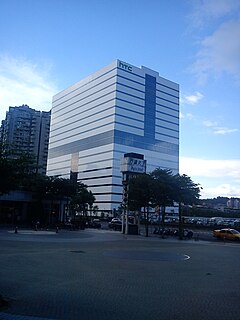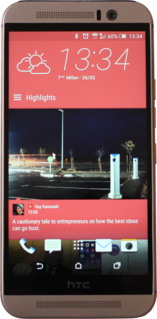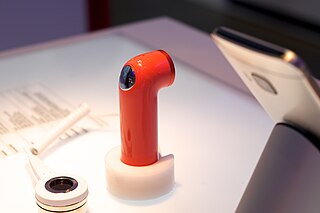Related Research Articles

HTC Corporation is a Taiwanese consumer electronics company headquartered in Xindian District, New Taipei City, Taiwan. Founded in 1997, HTC began as an original design manufacturer and original equipment manufacturer, designing and manufacturing laptop computers.
HTC Sense is a software suite developed by HTC, used primarily on the company's Android-based devices. Serving as a successor to HTC's TouchFLO 3D software for Windows Mobile, Sense modifies many aspects of the Android user experience, incorporating additional features, additional widgets, re-designed applications, and additional HTC-developed applications. The first device with Sense, the HTC Hero, was released in 2009. The HD2 running Windows Mobile 6.5, released later the same year, included Sense. Following the release of the Hero, all future Android devices by HTC were shipped with Sense, except for the Nexus One, the T-Mobile G2, the HTC First, the Google Pixel and Pixel 2, and the Nexus 9 which used a stock version of Android. Also some HTC smartphones that are using MediaTek processors come without HTC Sense.

HTC is the original design manufacturer for many Android and Windows Phone-based smartphones and PDAs. Brands that market or previously marketed HTC-manufactured products include Dell, Fujitsu Siemens, HP/Compaq, i-mate, Krome, O2, Palm, Sharp Corporation, and UTStarcom. HTC also manufactures ultra-mobile PCs, and is also the manufacturer of the Nexus One and Nexus 9, a smartphone and tablet designed and branded by Google, respectively.

The HTC Desire is the first smartphone of the Desire series developed by HTC. It was announced on 16 February 2010 and released in Europe and Australia in the second quarter of the same year. The HTC Desire was HTC's third flagship phone running Android 2.1 Eclair which can be upgraded to 2.2 Froyo or 2.3 Gingerbread. Internally it bears a strong resemblance to the Nexus One, but differs in some features.

The HTC One X is a touchscreen-based, slate-sized smartphone designed and manufactured by HTC. It was released running Android 4.0.3, with the HTC Sense 4.0 skin. It was the first HTC phone to be equipped with a quad-core processor, although the XL variant only has the dual-core 1.5 GHz Krait processor. The One X was announced on February 26, 2012 at the Mobile World Congress and was HTC's sixth flagship product, leading the HTC One series from the time of its release through April 2013, when its successor the HTC One (M7) was announced.
HTC One is a series of Android and Windows Phone smartphones designed and manufactured by HTC. All products in the One series were designed to be touchscreen-based and slate-sized, and to initially run the Android mobile operating system with the HTC Sense graphical user interface. The one exception to this is the HTC One (M8), which came in a Windows Phone variant in addition to several Android variants. From 2010 to 2013, all HTC products starting from the HTC Sensation XE to the HTC One Mini were equipped with a Beats Audio equalizer. Later HTC devices beginning with the HTC One Max no longer ship with Beats Audio following the buyback of HTC's stake in Beats Electronics.

The HTC Butterfly is an Android-based, 4G LTE-capable smartphone designed and developed by HTC. First announced for release in Japan by Japanese carrier KDDI as the HTC J Butterfly (HTL21), the J Butterfly was released in Japan on 9 December 2012 as the successor to the HTC J. Outside Japan, in other Asian countries, the phone was released as the HTC Butterfly (X920d) and in China and Russia as the HTC Butterfly (X920e). The Chinese/Russian and US versions of the Butterfly do not have a microSD slot. In the United States, the Butterfly was released as the HTC Droid DNA as a Verizon exclusive, supporting wireless charging. The DNA would become Verizon's final non-Motorola Droid smartphone; following its replacement in August 2013 by the HTC One and Droid Maxx, the carrier announced that all future Droid phones would be built exclusively by Motorola. In June 2013, the Butterfly was succeeded by the HTC Butterfly S.

HTC One is a touchscreen-based Android smartphone designed, developed, and manufactured by HTC. The smartphone was unveiled on 19 February 2013 at press events in New York City and London and is HTC's seventh flagship smartphone. It is the successor to the company's 2012 flagship model, the One X—which was critically acclaimed, but commercially unsuccessful due in part to insufficient marketing efforts. To make the device stand out among its competition, HTC One was developed with a major emphasis on unique hardware and software features; which included a unibody aluminum frame, a 1080p full-HD display, dual front-facing stereo speakers, a camera with a custom image sensor and the ability to automatically generate montages of media, an updated version of HTC's Sense user experience, BlinkFeed—an aggregator of news and social network content, and an electronic program guide app with the ability to serve as a universal remote via an IR blaster located in the device's power button.
The HTC Desire 601 is an Android smartphone designed and manufactured by HTC. The Desire 601 is a mid-range device carrying design traits from the HTC One and One Mini, utilizing a dual-core processor, 4.5-inch qHD display, and offering LTE support.

The HTC One (M8) is an Android or Windows smartphone manufactured and marketed by HTC. Following a number of leaks that occurred during the months prior, the device was officially unveiled in a press conference on March 25, 2014, and released the same day by Verizon Wireless at retail, and by other Canadian and United States carriers for online orders prior to its wider retail availability in mid-April.

The HTC Desire 816 is a mid ranged Android-based smartphone designed and manufactured by HTC. Announced at the 2014 Mobile World Congress in Barcelona, Spain, it features a 5.5-inch super LCD 2 display with a 1280x720 resolution, with full HD video recording and play-back.
The HTC Desire 610 is an Android-based smartphone designed and manufactured by HTC. The smartphone was announced at Mobile World Congress 2014 in Barcelona, Spain, Australia released the handset on 5 August 2014. It is an affordable smartphone part of the Desire range of mid-range handsets, and is aimed at the same market sector as devices such as the Motorola Moto G, Sony Xperia M2 and Nokia Lumia 735.
The HTC One (E8) is a high-end Android smartphone released by HTC in 2014. It has been described as a cheaper version of the HTC One (M8), and the two devices share many similar features.

The HTC One M9 is an Android smartphone manufactured and marketed by HTC. The third-generation One was officially unveiled in a press conference at Mobile World Congress on March 1, 2015 and it was released to wide retail availability on April 10, 2015. It is the successor to HTC One (M8).

The HTC One A9 is an Android smartphone manufactured and marketed by HTC. It was officially announced on October 20, 2015. It is the successor to the HTC One Mini 2 in the Worldwide; but in global markets, it was sold alongside the One M9 as a mid-range offering. It was launched as an effort to improve the revenue of HTC's smartphone business after the failure of the One M9.

The HTC RE Camera is a camera introduced by HTC in 2014. It offers a 16MP sensor supporting 1080p video capture, intrusion protection, and is able to connect with smartphones through a dedicated application. Reception to the camera has been mostly positive.
The HTC Desire 520 is a low-end Android smartphone released by HTC in 2015. The phone received mixed reviews. CNET described the phone as "[a] cheap Android device that sacrifices too much". Gadget Guy noted the phone's long battery life, but also described the phone as "one of the slowest phones [they have] ever reviewed" and its screen quality as sub-par.
The HTC Desire 616 is a mid-range Android smartphone released by HTC in 2014. The phone received mixed reviews. Aloysius Low of CNET described the phone as "[a] good-looking device suffering from underwhelming performance". Ershad Kaleebullah of NDTV was unwilling to recommend the phone when compared to similarly priced alternatives such as the Xiaomi Mi 3.
The HTC Desire 510 is a mid-range Android smartphone released by HTC in 2014.

The HTC 10 is an Android smartphone manufactured and marketed by HTC. It was announced on April 12, 2016.
References
- ↑ Nether, Kevin (October 15, 2014). "HTC Butterfly 2 Review". Android Authority. Retrieved 2019-04-16.
- ↑ Low, Aloysius (September 1, 2014). "HTC Butterfly 2 review". CNET. Retrieved 2019-04-16.